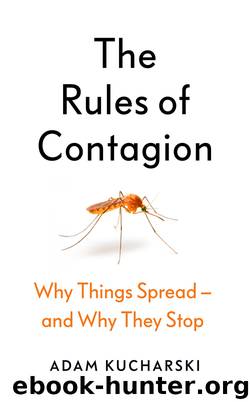The Rules of Contagion by Adam Kucharski

Author:Adam Kucharski
Language: eng
Format: epub, azw3
Publisher: Profile
Published: 2020-02-12T16:00:00+00:00
Initial retweets about the Higgs boson rumour, 1 July 2012. Each dot represents a user, with lines showing retweets
Data: De Domenico et al., 2013
For infectious diseases, we’ve seen there are two extreme types of outbreaks. ‘Common source’ transmission occurs when everyone gets infected from the same source, like food poisoning. At the other extreme, a propagated outbreak spreads from person-to-person over several generations. There is a similar diversity in online cascades. Sometimes content will spread to lots of people from a single source – known in marketing as a ‘broadcast’ event – whereas on other occasions it will propagate from user to user. The Stanford and Microsoft researchers found that broadcasts were a crucial part of the largest cascades. About one in a thousand Twitter posts got more than 100 shares, but only a fraction of these spread because of propagated transmission. Of the posts that spread, there was generally a single broadcast event behind its success.
When we talk about online contagion, it’s tempting to focus only on things that have become popular. However, this ignores the fact that the vast majority of things do not take off. The Microsoft team found that around 95 per cent of Twitter cascades consisted of a single tweet that nobody else shared. Of the remaining cascades, most didn’t go any further than one additional step in terms of sharing. The same is true of other online platforms: it’s extremely rare to get something that spreads, and even when it does, it doesn’t spread beyond a few generations of transmission. Most content just isn’t that contagious.[41]
In the previous chapter, we looked at outbreaks of shootings in Chicago, where transmission generally ended after a small number of events. Several diseases also stumble and stutter in human populations like this. For example, strains of bird flu like H5N1 and H7N9 have caused large outbreaks in poultry, but don’t spread well among people (at least, not for the moment).
What sort of outbreaks should we expect if something doesn’t spread very effectively? We’ve already looked at how we can use the reproduction number, R, to assess whether an infectious disease has the potential to spread or not; if R is above the critical value of one, there is potential for a large epidemic to occur. But even if R is below one, there’s still a chance an infected person will pass the disease on to someone else. It might be unlikely, but it’s possible. Unless the reproduction number is zero, we should therefore expect to get some secondary cases occasionally. These new cases may generate further generations of infection before the outbreak eventually stutters to an end.
If we know the reproduction number of a stuttering infection, can we predict how big an outbreak will be on average? It turns out that we can, thanks to a handy piece of mathematics. As well as becoming a crucial part of outbreak analysis, it’s an idea that would shape how Jonah Peretti and Duncan Watts approached viral marketing in the early days of Buzzfeed.
Download
This site does not store any files on its server. We only index and link to content provided by other sites. Please contact the content providers to delete copyright contents if any and email us, we'll remove relevant links or contents immediately.
Periodization Training for Sports by Tudor Bompa(8170)
Why We Sleep: Unlocking the Power of Sleep and Dreams by Matthew Walker(6618)
Paper Towns by Green John(5089)
The Immortal Life of Henrietta Lacks by Rebecca Skloot(4525)
The Sports Rules Book by Human Kinetics(4294)
Dynamic Alignment Through Imagery by Eric Franklin(4118)
ACSM's Complete Guide to Fitness & Health by ACSM(3989)
Kaplan MCAT Organic Chemistry Review: Created for MCAT 2015 (Kaplan Test Prep) by Kaplan(3940)
Introduction to Kinesiology by Shirl J. Hoffman(3726)
Livewired by David Eagleman(3684)
The Death of the Heart by Elizabeth Bowen(3552)
The River of Consciousness by Oliver Sacks(3541)
Alchemy and Alchemists by C. J. S. Thompson(3451)
Bad Pharma by Ben Goldacre(3356)
Descartes' Error by Antonio Damasio(3230)
The Emperor of All Maladies: A Biography of Cancer by Siddhartha Mukherjee(3066)
The Gene: An Intimate History by Siddhartha Mukherjee(3047)
The Fate of Rome: Climate, Disease, and the End of an Empire (The Princeton History of the Ancient World) by Kyle Harper(3003)
Kaplan MCAT Behavioral Sciences Review: Created for MCAT 2015 (Kaplan Test Prep) by Kaplan(2940)
